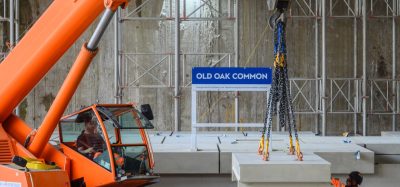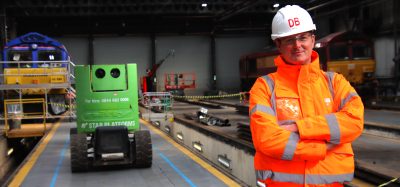Success of unavoidable maintenance
Posted: 28 November 2006 | | No comments yet
A £14 million scheme to replace and refurbish the Leven viaduct in South Cumbria was successfully completed by Network Rail on time and within budget in July 2006. The 16 week project is the largest civil engineering bridge scheme in a five-year programme of work in the London North Western Territory and demonstrates a commitment by Network Rail to the Barrow line and the economies of South Cumbria.
A £14 million scheme to replace and refurbish the Leven viaduct in South Cumbria was successfully completed by Network Rail on time and within budget in July 2006. The 16 week project is the largest civil engineering bridge scheme in a five-year programme of work in the London North Western Territory and demonstrates a commitment by Network Rail to the Barrow line and the economies of South Cumbria.
A £14 million scheme to replace and refurbish the Leven viaduct in South Cumbria was successfully completed by Network Rail on time and within budget in July 2006. The 16 week project is the largest civil engineering bridge scheme in a five-year programme of work in the London North Western Territory and demonstrates a commitment by Network Rail to the Barrow line and the economies of South Cumbria.
The Leven viaduct is a 49 span structure carrying the Carnforth to Barrow line across the Leven Estuary in South Cumbria. It consists of an iron and steel deck structure supported on cast iron piers clad in reinforced concrete and brick. The track is bullhead rail supported on long-timbers.
The viaduct was originally constructed in 1857 under the guidance of John Brogden and his sons. It is even believed that George Stephenson did not think the scheme was feasible and offered his hearty congratulations to John Brogden on completion of the project. The Brogden family had previously worked on other structures in the North West including the Castlefield viaduct, which opened in 1849 and carries one of the principal routes into Manchester from Salford.
The family had also assisted with building railways through Altrincham and East Lancashire before tackling the more complex and demanding Leven viaduct construction.
It was widened to accommodate a twin track in 1863 and in 1867 the Ulvserstone and Lancaster Railway, as it was known then, opened to passenger trains, ten years after it had opened to freight traffic.
Major repairs to the structure were undertaken in 1915, when the cast iron piers were encapsulated in brickwork and reinforced concrete, and some of the deck was replaced. The last major repairs were made to the structure during the 1950s when maintenance was carried out on the steelwork. The combination of ageing materials and extreme weather conditions caused the structure to deteriorate to the point where it came to the end of its natural life. Unfortunately routine maintenance of the structure failed to prevent this from happening.
The Cumbria coast line is viewed as a vital link to the local economies of Cumbria with passenger services to the south, Manchester and Manchester Airport. In addition to this, freight traffic from the British Nuclear Fuels Limited (BNFL) Sellafield reprocessing plant uses the line as a main transportation route in and out of the site. As a vital passenger and freight line Network Rail needed to carry out repairs to the viaduct to enable the route to stay open.
Why?
A detailed examination of the structure in 2003 revealed that the viaduct was in an advanced condition of deterioration and required major maintenance work. This work was brought on by a combination of ageing materials and extreme weather conditions and unfortunately routine maintenance failed to prevent the structure deteriorating.
There were temporary speed restrictions on the viaduct. If the work was not carried out, gradually Network Rail would have had to reduce the speed of trains across the viaduct, until eventually it would have no choice but to close the line permanently.
Network Rail began devising a detailed programme of work. It was originally anticipated that the line would have to close for 16 weeks during 2006 and a further 16 weeks in 2007 but the feasibility of using two gantries on the viaduct to lift out the old deck plates and put in place the new units meant that contractors, Carillion, could complete the scheme in a single line closure.
Network Rail carried out the work during the spring and summer months because of the longer daylight hours, which meant its contractors could work for longer periods of time, the blockade was shorter and there was less chance of the project falling behind due to extreme weather conditions. Better weather also meant there were safer working conditions for the contractor.
Network Rail planned the work to finish before the start of the summer school holidays when more tourists travel to the area and local people rely on train services to get to their holiday destinations.
Impact on the local area?
Network Rail consulted BNFL who said they did not anticipate having to transport any nuclear fuel during the blockade, although provisions were made for services to be diverted via Carlisle if necessary. Network Rail was assured that no nuclear fuel would be transported by road during the blockade.
Unfortunately, due to other work being carried out on the line at Grange-over-Sands, (which was being carried out during the blockade to ensure the line was not closed for a second year running in 2007), no materials could be delivered by rail. Network Rail transported the materials by road and used three main access points. These were at Ulverston, where the new decks were delivered; at Plumpton Junction where the main compound was set up and at Cark, to which the old decks were removed.
Residents close to the main compound were notified about the compound and Network Rail wrote to other residents nearer to the start of the blockade.
All the new decks were transported to Ulverston by HGV. The sustained delivery time and large storage area meant local people saw between one and four HGV movements in and out of Ulverston and Cark a day. Network Rail did everything it could to ensure there were no deliveries on a weekend or Bank Holiday when traffic was heavier.
How?
The contractors, Carillion, worked on the structure for six days a week and for 10 hours a day. By carrying out the project during the spring and summer months, more work was carried out during longer working hours, minimising the risk of the project falling behind due to extreme weather conditions.
The contractor removed and replaced the entire deck across the full length of the structure, a total of 490 metres. The new deck was designed to be compliant with modern standards and as such provides a much safer operating and maintenance environment.
48 spans were removed and replaced with 96 pre-fabricated steel decks. These decks were specially made off-site and transported to the viaduct by rail from Ulverston. The old decks were removed and taken by rail to Cark. Span 37, which is approximately 20 metres long and originally opened to allow ships access to the estuary, was going to be difficult to replace because of its size.
A detailed assessment of the span, as well as scientific analysis proved that a full refurbishment would bring it up to the required strength and be in line with the remainder of the structure. This was one of the biggest challenges that faced the project team. Until they carried out the analysis it was not known how much refurbishment would be required or if it would be possible to refurbish rather than replace the span. It was a partial ‘unknown quantity’ within the project and could have affected the entire scheme.
The project also involved one of the first major applications of a new direct fixing rail system within the UK using ‘Pandrol Vipa Baseplates’. This system, which originates from New Zealand, had previously been used on the Liverpool loop line to fix rail to slab concrete, but this is the first time it has been used in the North West to attach track directly on to a structure. One of the advantages of using this system is that the track can be aligned much more precisely but it does require complete accuracy when the units are installed. The viaduct now has continuously welded track ending the familiar ‘clickerty clack’ noise and the ‘Vipa Baseplates’ act as buffers between the track and viaduct meaning passengers now benefit from much smoother and quieter journeys.
Project challenges
Some of the other challenges that faced the project team were the weather and location of the viaduct. Due to health and safety requirements and because the viaduct crosses moving water, no one could work on the structure during high winds. This meant there was an element of unpredictability within the timing of the project.
Everyone working on or visiting the viaduct was required to wear a life jacket and there was a safety boat on standby should the worst have happened. In actual fact, Network Rail had to employ a hovercraft rather than a conventional boat because at low tide the water is very shallow.
Unfortunately, strong winds within the first few weeks of the scheme meant there was a total of twelve days when work could not be carried out. A contingency, which was built into the scheme and a re-scheduling of the work, still meant that the work was completed on time and the line re-opened on 17 July 2006. The viaduct also falls within a Site of Special Scientific Interest (SSSI) and this meant that the project had to be environmentally sensitive. Network Rail sought independent environmental advice before and during the scheme.
The safety hovercraft was never used ‘in anger’ but did see action one morning mid way through the project. Work to cut up the old steel decking before it was removed was temporarily halted when a young dolphin was spotted floundering in the shallow waters below the viaduct. It was feared the showers of sparks from the cutting equipment might have harmed the creature. The safety hovercraft was called upon to try and usher the dolphin towards deeper water but to no avail. In the end, one of the safety team jumped out of the hovercraft, scooped the dolphin up into his arms, got back into the craft and released it in the deeper waters of the estuary.







